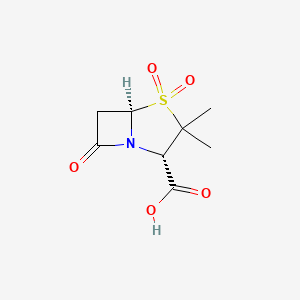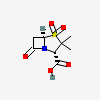Sulbactam
- SULBACTAM
- 68373-14-8
- Betamaze
- Penicillanic Acid Sulfone
- Sulbactamum
- Create:2005-06-24
- Modify:2025-01-18
 Sulbactam Sodium (has salt form);
Sulbactam Sodium (has salt form);  Sulbactam Pivoxil (is active moiety of);
Sulbactam Pivoxil (is active moiety of);  Sulbactam Benzathine (is active moiety of).
Sulbactam Benzathine (is active moiety of).
- Bétamaze
- Combactam
- CP 45899
- CP-45899
- CP45899
- Penicillanic Acid Sulfone
- Sodium, Sulbactam
- Sulbactam
- Sulbactam Sodium
- Sulfone, Penicillanic Acid
- SULBACTAM
- 68373-14-8
- Betamaze
- Penicillanic Acid Sulfone
- Sulbactamum
- (2S,5R)-3,3-dimethyl-7-oxo-4-thia-1-azabicyclo[3.2.0]heptane-2-carboxylic acid 4,4-dioxide
- penicillanic acid 1,1-dioxide
- sulbactam acid
- (2S,5R)-3,3-Dimethyl-7-oxo-4-thia-1-azabicyclo(3.2.0)heptane-2-carboxylic acid 4,4-dioxide
- UNII-S4TF6I2330
- CHEBI:9321
- CP 45899
- DTXSID1023605
- CP-45,899
- S4TF6I2330
- MFCD00867005
- EINECS 269-878-2
- Sulbactamum [INN-Latin]
- CHEMBL403
- NSC-759886
- CP-45899
- CP-458992
- DTXCID503605
- Sulbactam (INN)
- 68373-14-8 (free acid)
- (2S,5R)-3,3-dimethyl-4,4,7-trioxo-4$l^{6}-thia-1-azabicyclo[3.2.0]heptane-2-carboxylic acid
- 2,2-dimethyl-1,1-dioxidopenam-3alpha-carboxylic acid
- NSC 759886
- 4-Thia-1-azabicyclo[3.2.0]heptane-2-carboxylic acid,3,3-dimethyl-7-oxo-, 4,4-dioxide, (2S,5R)-
- Sulbactam 100 microg/mL in Acetonitrile
- SULBACTAM [INN]
- Sulbactamum (INN-Latin)
- SULBACTAM (MART.)
- SULBACTAM [MART.]
- SULBACTAM (USP-RS)
- SULBACTAM [USP-RS]
- (2S,5R)-3,3-dimethyl-4,4,7-trioxo-4lambda6-thia-1-azabicyclo[3.2.0]heptane-2-carboxylic acid
- (2S,5R)-3,3-Dimethyl-7-oxo-4-thia-1-azabicyclo(3.2.0)heptan-2-carbonsaeure 4,4-dioxid
- 4-Thia-1-azabicyclo(3.2.0)heptane-2-carboxylic acid, 3,3-dimethyl-7-oxo-, 4,4-dioxide, (2S-cis)-
- CP45899
- SMR000387064
- Sulbactam (sodium salt)
- CAS-68373-14-8
- SULTAMICILLIN IMPURITY A (EP IMPURITY)
- SULTAMICILLIN IMPURITY A [EP IMPURITY]
- Sulbactam [INN:BAN]
- SR-01000760610
- Penicillanic acid dioxide
- Sulfone, Penicillanic Acid
- Sulbactam,(S)
- 0RN
- Betamaze sodium salt;CP45899 sodium salt
- Sulbactam (Standard)
- SULBACTAM [MI]
- SULBACTAM [VANDF]
- NCGC00159487-06
- Sulbactam; Sulbactam Acid
- SULBACTAM [WHO-DD]
- SCHEMBL47781
- MLS001048859
- MLS001304017
- Penicillanic acid S,S-dioxide
- GTPL10769
- HY-B0334R
- J01CG01
- HMS2090E07
- HMS2269A12
- HMS3651C06
- HMS3715B09
- BCP13271
- EX-A2000
- HY-B0334
- Tox21_113642
- BBL033518
- BDBM50021954
- s1958
- STK801889
- AKOS004119988
- Tox21_113642_1
- CCG-221124
- DB09324
- KS-5198
- Sulbactam, analytical reference material
- NCGC00159336-02
- NCGC00159336-03
- NCGC00159336-05
- AC-18973
- BS167314
- NS00007741
- S0868
- C07770
- D08533
- EN300-122646
- AB00698109-06
- AB00698109-08
- AB00698109_09
- Q423393
- SR-01000760610-2
- SR-01000760610-3
- BRD-K44133266-001-10-0
- BRD-K44133266-236-02-9
- Z1563146038
- Sulbactam, European Pharmacopoeia (EP) Reference Standard
- Sulbactam, United States Pharmacopeia (USP) Reference Standard
- (2S,5R)-3,3-Dimethyl-4,4,7-trioxo-4-thia-1-azabicyclo[3.2.0]heptane-2-carboxylic acid
- (2S,5R)-3,3-dimethyl-7-oxo-4-thia-1-azabicyclo[3.2.0]heptane-2-carboxylicacid4,4-dioxide
- 3,3-Dimethyl-4,4,7-trioxo-4lambda*6*-thia-1-aza-bicyclo[3.2.0]heptane-2-carboxylic acid
- Sulbactam for peak identification, European Pharmacopoeia (EP) Reference Standard
- (2S,5R)-3,3-dimethyl-4,4,7-trioxo-4|E6-thia-1-azabicyclo[3.2.0]heptane-2-carboxylic acid
- (2S,5R)-3,3-Dimethyl-4,4,7-trioxo-4lambda*6*-thia-1-aza-bicyclo[3.2.0]heptane-2-carboxylic acid
- (2S,5R)-3,3-Dimethyl-7-oxo-4-thia-1-azabicyclo-[3.2.0]heptane-2-carboxylic acid 4,4-dioxide
- (2S,5R)?-?3,3-?dimethyl-?7-?oxo-?4-?thia-?1-?azabicyclo[3.2.0]?heptane-?2-?carboxylic acid 4,4-dioxide
- (S)-3,3-Dimethyl-7-(R)-oxo-4,4-dioxo-4lambda*6*-thia-1-aza-bicyclo[3.2.0]heptane-2-carboxylic acid
- 3,3-Dimethyl-4,4,7-trioxo-4lambda*6*-thia-1-aza-bicyclo[3.2.0]heptane-2-carboxylic acid (Sulbactam)
- 4-Thia-1-azabicyclo[3.2.0]heptane-2-carboxylic acid, 3,3-dimethyl-7-oxo-,4,4-dioxide, (2S, cis)
Sulbactam Sodium (has salt form)
Sulbactam Pivoxil (is active moiety of)
Sulbactam Benzathine (is active moiety of)
Use (kg; approx.) in Germany (2009): >10000
Use (kg; exact) in Germany (2009): 27580
Use (kg) in USA (2002): 6920
Consumption (g per capita; approx.) in Germany (2009): 0.122
Consumption (g per capita; exact) in Germany (2009): 0.337
Consumption (g per capita) in the USA (2002): 0.0245
Excretion rate: 0.8
Calculated removal (%): 75.1


H302 (51.9%): Harmful if swallowed [Warning Acute toxicity, oral]
H317 (46.8%): May cause an allergic skin reaction [Warning Sensitization, Skin]
H334 (46.8%): May cause allergy or asthma symptoms or breathing difficulties if inhaled [Danger Sensitization, respiratory]
P233, P260, P261, P264, P270, P271, P272, P280, P284, P301+P317, P302+P352, P304+P340, P321, P330, P333+P317, P342+P316, P362+P364, P403, and P501
(The corresponding statement to each P-code can be found at the GHS Classification page.)
Aggregated GHS information provided per 79 reports by companies from 7 notifications to the ECHA C&L Inventory. Each notification may be associated with multiple companies.
Reported as not meeting GHS hazard criteria per 1 of 79 reports by companies. For more detailed information, please visit ECHA C&L website.
There are 6 notifications provided by 78 of 79 reports by companies with hazard statement code(s).
Information may vary between notifications depending on impurities, additives, and other factors. The percentage value in parenthesis indicates the notified classification ratio from companies that provide hazard codes. Only hazard codes with percentage values above 10% are shown.
Acute Tox. 4 (51.9%)
Skin Sens. 1 (46.8%)
Resp. Sens. 1 (46.8%)
Patents are available for this chemical structure:
https://patentscope.wipo.int/search/en/result.jsf?inchikey=FKENQMMABCRJMK-RITPCOANSA-N
- BindingDBLICENSEAll data curated by BindingDB staff are provided under the Creative Commons Attribution 3.0 License (https://creativecommons.org/licenses/by/3.0/us/).https://www.bindingdb.org/rwd/bind/info.jsp(2S,5R)-3,3-Dimethyl-4,4,7-trioxo-4lambda*6*-thia-1-aza-bicyclo[3.2.0]heptane-2-carboxylic acidhttps://www.bindingdb.org/rwd/bind/chemsearch/marvin/MolStructure.jsp?monomerid=50021954
- Comparative Toxicogenomics Database (CTD)LICENSEIt is to be used only for research and educational purposes. Any reproduction or use for commercial purpose is prohibited without the prior express written permission of NC State University.http://ctdbase.org/about/legal.jsp
- DrugBankLICENSECreative Common's Attribution-NonCommercial 4.0 International License (http://creativecommons.org/licenses/by-nc/4.0/legalcode)https://www.drugbank.ca/legal/terms_of_use
- CAS Common ChemistryLICENSEThe data from CAS Common Chemistry is provided under a CC-BY-NC 4.0 license, unless otherwise stated.https://creativecommons.org/licenses/by-nc/4.0/
- ChemIDplusSulbactam [INN:BAN]https://pubchem.ncbi.nlm.nih.gov/substance/?source=chemidplus&sourceid=0068373148ChemIDplus Chemical Information Classificationhttps://pubchem.ncbi.nlm.nih.gov/source/ChemIDplus
- EPA DSSToxCompTox Chemicals Dashboard Chemical Listshttps://comptox.epa.gov/dashboard/chemical-lists/
- European Chemicals Agency (ECHA)LICENSEUse of the information, documents and data from the ECHA website is subject to the terms and conditions of this Legal Notice, and subject to other binding limitations provided for under applicable law, the information, documents and data made available on the ECHA website may be reproduced, distributed and/or used, totally or in part, for non-commercial purposes provided that ECHA is acknowledged as the source: "Source: European Chemicals Agency, http://echa.europa.eu/". Such acknowledgement must be included in each copy of the material. ECHA permits and encourages organisations and individuals to create links to the ECHA website under the following cumulative conditions: Links can only be made to webpages that provide a link to the Legal Notice page.https://echa.europa.eu/web/guest/legal-noticeSulbactam (EC: 269-878-2)https://echa.europa.eu/information-on-chemicals/cl-inventory-database/-/discli/details/20519
- FDA Global Substance Registration System (GSRS)LICENSEUnless otherwise noted, the contents of the FDA website (www.fda.gov), both text and graphics, are not copyrighted. They are in the public domain and may be republished, reprinted and otherwise used freely by anyone without the need to obtain permission from FDA. Credit to the U.S. Food and Drug Administration as the source is appreciated but not required.https://www.fda.gov/about-fda/about-website/website-policies#linking
- New Zealand Environmental Protection Authority (EPA)LICENSEThis work is licensed under the Creative Commons Attribution-ShareAlike 4.0 International licence.https://www.epa.govt.nz/about-this-site/general-copyright-statement/4-Thia-1-azabicyclo3.2.0heptane-2-carboxylic acid, 3,3-dimethyl-7-oxo-, 4,4-dioxide, (2S,5R)-https://www.epa.govt.nz/industry-areas/hazardous-substances/guidance-for-importers-and-manufacturers/hazardous-substances-databases/
- ChEBI
- FDA Pharm ClassesLICENSEUnless otherwise noted, the contents of the FDA website (www.fda.gov), both text and graphics, are not copyrighted. They are in the public domain and may be republished, reprinted and otherwise used freely by anyone without the need to obtain permission from FDA. Credit to the U.S. Food and Drug Administration as the source is appreciated but not required.https://www.fda.gov/about-fda/about-website/website-policies#linkingFDA Pharmacological Classificationhttps://www.fda.gov/ForIndustry/DataStandards/StructuredProductLabeling/ucm162549.htm
- NCI Thesaurus (NCIt)LICENSEUnless otherwise indicated, all text within NCI products is free of copyright and may be reused without our permission. Credit the National Cancer Institute as the source.https://www.cancer.gov/policies/copyright-reuseNCI Thesaurushttps://ncit.nci.nih.gov
- Open TargetsLICENSEDatasets generated by the Open Targets Platform are freely available for download.https://platform-docs.opentargets.org/licence
- ChEMBLLICENSEAccess to the web interface of ChEMBL is made under the EBI's Terms of Use (http://www.ebi.ac.uk/Information/termsofuse.html). The ChEMBL data is made available on a Creative Commons Attribution-Share Alike 3.0 Unported License (http://creativecommons.org/licenses/by-sa/3.0/).http://www.ebi.ac.uk/Information/termsofuse.htmlChEMBL Protein Target Treehttps://www.ebi.ac.uk/chembl/g/#browse/targets
- ClinicalTrials.govLICENSEThe ClinicalTrials.gov data carry an international copyright outside the United States and its Territories or Possessions. Some ClinicalTrials.gov data may be subject to the copyright of third parties; you should consult these entities for any additional terms of use.https://clinicaltrials.gov/ct2/about-site/terms-conditions#Use
- DailyMed
- EU Clinical Trials Register
- Japan Chemical Substance Dictionary (Nikkaji)
- KEGGLICENSEAcademic users may freely use the KEGG website. Non-academic use of KEGG generally requires a commercial licensehttps://www.kegg.jp/kegg/legal.htmlAnatomical Therapeutic Chemical (ATC) classificationhttp://www.genome.jp/kegg-bin/get_htext?br08303.kegAntiinfectiveshttp://www.genome.jp/kegg-bin/get_htext?br08307.keg
- Metabolomics Workbench
- NIPH Clinical Trials Search of Japan
- NLM RxNorm TerminologyLICENSEThe RxNorm Terminology is created by the National Library of Medicine (NLM) and is in the public domain and may be republished, reprinted and otherwise used freely by anyone without the need to obtain permission from NLM. Credit to the U.S. National Library of Medicine as the source is appreciated but not required. The full RxNorm dataset requires a free license.https://www.nlm.nih.gov/research/umls/rxnorm/docs/termsofservice.html
- NORMAN Suspect List ExchangeLICENSEData: CC-BY 4.0; Code (hosted by ECI, LCSB): Artistic-2.0https://creativecommons.org/licenses/by/4.0/SulbactamNORMAN Suspect List Exchange Classificationhttps://www.norman-network.com/nds/SLE/
- Protein Data Bank in Europe (PDBe)
- RCSB Protein Data Bank (RCSB PDB)LICENSEData files contained in the PDB archive (ftp://ftp.wwpdb.org) are free of all copyright restrictions and made fully and freely available for both non-commercial and commercial use. Users of the data should attribute the original authors of that structural data.https://www.rcsb.org/pages/policies
- SpectraBase(2S,5R)-3,3-dimethyl-7-oxo-4-thia-1-azabicyclo(3.2.0)heptan-2-carbonsaeure 4,4-dioxidhttps://spectrabase.com/spectrum/GQAqhlMmlfh
- Springer Nature
- Thieme ChemistryLICENSEThe Thieme Chemistry contribution within PubChem is provided under a CC-BY-NC-ND 4.0 license, unless otherwise stated.https://creativecommons.org/licenses/by-nc-nd/4.0/
- WHO Anatomical Therapeutic Chemical (ATC) ClassificationLICENSEUse of all or parts of the material requires reference to the WHO Collaborating Centre for Drug Statistics Methodology. Copying and distribution for commercial purposes is not allowed. Changing or manipulating the material is not allowed.https://www.whocc.no/copyright_disclaimer/
- Wikidata
- Wikipedia
- Medical Subject Headings (MeSH)LICENSEWorks produced by the U.S. government are not subject to copyright protection in the United States. Any such works found on National Library of Medicine (NLM) Web sites may be freely used or reproduced without permission in the U.S.https://www.nlm.nih.gov/copyright.htmlAnti-Bacterial Agentshttps://www.ncbi.nlm.nih.gov/mesh/68000900beta-Lactamase Inhibitorshttps://www.ncbi.nlm.nih.gov/mesh/68065093
- PubChem
- GHS Classification (UNECE)GHS Classification Treehttp://www.unece.org/trans/danger/publi/ghs/ghs_welcome_e.html
- MolGenieMolGenie Organic Chemistry Ontologyhttps://github.com/MolGenie/ontology/
- PATENTSCOPE (WIPO)SID 390610971https://pubchem.ncbi.nlm.nih.gov/substance/390610971

